Bloodletting / Michael McBride
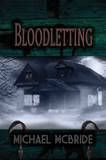 Delirium Books / March 2009
Delirium Books / March 2009
Reviewed by: JG Faherty
Move over, Preston and Child, step aside James Rollins, there’s a new fellow coming up fast behind you. His name is Michael McBride, and with his new book, Bloodletting, he’s giving notice that he’s a force to be reckoned with, not only in horror but in the mainstream action/thriller genre as well.
Looking back, I can see the progression in McBride’s writing that’s led to this point, from solid horror with a bit of action thrown in (The Infected), to more of a mix of the two genres (the God’s End trilogy), culminating in Bloodletting, a tightly-written, suspenseful, action-packed thriller filled with sudden twists, believable characters, and cutting edge science.
Bloodletting follows FBI Special Agent Paxton Carver as he attempts to track down a particularly vicious and demented serial killer. Carver is an agent with a reputation for always finding his man, but in this case the killer - or killers - remains elusive, staying one step ahead and taunting Carver with some seriously sick clues.
Along the way, Carver has to deal with mysteriously mummified remains, bodies drained of blood and organs, genetic anomalies, butchered corpses, amoral Nazi scientists, and more than one attack on his own life. He’s also trying to figure out how his case and two others keep overlapping, as if they’re all related. But that would mean something larger is going on, something that dates back decades.
As if that’s not enough, his high school sweetheart is somehow involved, possibly as the killer’s next target, there’s a mole in the FBI, and he’s being forced to work with a group of agents who not only seem to be operating as rogues, but appear to have more than a few habits in common with the psychopaths they’re tracking.
Carver’s search for the truth takes him through enough loops and sudden turns to keep the reader on his or her toes without descending into confusion, and McBride uses his words like a painter uses a fine brush, building suspense, teasing the reader along, and never resorting to stereotypical characters or plot devices. Even the secondary characters have distinct, realistic personalities, and they all play key, entertaining roles in the story as it evolves.
In the end, McBride closes Bloodletting in just the right fashion, providing closure while at the same time effectively setting up the opportunity for a sequel. In fact, in Paxton Carter, McBride has created a character around whom an entire series of books could be built, much the same as Preston and Child have done with Special Agent Pendergast.
By incorporating Mayan and Incan history together with his personal background in the biological sciences, McBride produces a scenario that is frighteningly chilling because of the potential for the events in his tale to become a reality in the not-so-distant future.
Without hesitation, I can say Bloodletting is the best book I’ve read in a long, long time. I recommend it to everyone, not just horror aficionados. In a story filled with surprises, the real question is why one of the big publishing houses hasn’t picked him up yet. While Delirium has done a fine production job, I can imagine Bloodletting achieving major nationwide sales if it had the backing of a larger company behind it.
In the end, McBride has taken his writing to a new level, and I for one am happy to climb along with him for the ride.
Purchase Bloodletting by Michael McBride.
The Black Act / Louise Bohmer
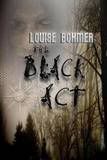 Lachesis Publishing / April 2009
Lachesis Publishing / April 2009
Reviewed by: Michele Lee
The Black Act is a lush, sensory tale of a pair of twins, Anna and Claire, who are the last of a cursed bloodline of wise women. Anna, hard at work as a scribe for their clan, begins having visions of the origins of the curse. Combining these with the knowledge of her elder, Rosalind, Anna must untangle the mystery of the curse in an attempt to prevent her twin, Claire, from falling into its embrace.
Bohmer's writing is beautiful and rich, and her creative abilities shine through in the wild, original fae that inhabit her world. However, there are some aspects of The Black Act that remain a bit sophomoric. For all its sensory indulgences, Bohmer's world remains fairly white bread. At times the characters seem almost interchangeable; men of either race are often untrustworthy or harboring a grudge; women are gentle, humble, and close to all knowing.
If there is a true flaw in The Black Act, it's a lack of forward momentum. More than the first half of the novel is spent explaining how the characters and world got to where it is at page one rather than moving forward from that point. A danger to any tale where the past so heavily affects the lead characters, some readers will be able to revel in the fullness of the world, whereas others will become tired of the prose, no matter how pretty.
Akin to The Witching Hour by Ann Rice, The Black Act shows potential that one hopes will grow and fruit stronger tales, which could undoubtedly be solid additions to the dark fantasy genre.
Purchase The Black Act by Louise Bohmer.
The Absence / Bill Hussey
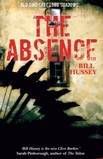 Bloody Books / April 2009
Bloody Books / April 2009
Reviewed by: Martel Sardina
Joe Nightingale killed his mother. Didn’t he? It certainly wasn’t his mother’s idea to go shopping that day and pick out the perfect gift for Samantha, his new girlfriend. Mother was just along for the ride. If she hadn’t gone with...if she had been the one driving...maybe she’d still be alive. It’s been months since her death and Joe can’t seem to stop blaming himself. Joe needs someone to tell him that he is not to blame. It would be nice if those words came from his father, Richard, or his brother, Bobby. But Mother’s death has changed them. Their silence on the matter is creating a rift in the family. The “Absence” is taking hold.
Bobby is still reeling from Mother’s death when he finds his friend, Matt, dead in the school locker room. While Matt’s parents struggle to make sense of their son’s apparent suicide, Bobby lies to them, claiming not to know why Matt took his own life. Matt’s ghost haunts Bobby over his inability to admit the truth.
Bobby isn’t the only one keeping secrets. Richard, his father, has plenty of his own. When the Nightingale family receives the news that they’ve inherited an old house from a distant relative, Richard jumps on the chance to escape from his shadows. A summer at Daecher’s Mill might just be the cure this family needs to overcome their tragic losses. The lure of escape should have been a warning that something darker awaits them.
As the Nightingales attempt to settle in their new home, strange things begin happening. They learn that a child was murdered here many years ago. Many people have been called to Daecher’s Mill in the years since and the ones who left alive were never quite the same. Why does Joe feel so connected to a place that should have no meaning to him?
The Absence is Bill Hussey’s second novel. His first effort - 2008's Through a Glass, Darkly - garnered high praise. Hussey’s work has been deemed worthy of comparison with horror greats such as Ramsey Campbell. While Hussey’s storytelling skill is impressive, only time will tell if such early remarks are truly deserved.
Much of novel’s execution is flawless. However, there were a few moments when it felt like the characters were not acting as they should. Bobby seems wise beyond his years. At times, some of the dialogue feels contrived and preachy. While the imagery at the end is sufficiently creepy, this reviewer would have liked an ending with a bit more ambiguity.
That said, the quality of the writing and the story itself was good enough to pique this reviewer’s interest in reading Hussey’s debut. Hussey may or may not pan out to be the “new” Ramsey Campbell or Clive Barker, but he’s definitely a writer worth reading and one to watch out for in the years to come.
Purchase The Absence by Billy Hussey.
Vampire Apocalypse: Descent into Chaos / Derek Gunn
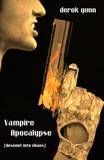 KHP Publishers / September 2008
KHP Publishers / September 2008
Reviewed by: Derek Clendening
Vampires have taken over the world and life as we know it has been forever changed. In Descent into Chaos, the second in the Vampire Apocalypse series, author Derek Gunn appeals to the reader’s suspension of disbelief, and suggests how society would function with vampires at the helm. And these vampires are very much different from others in literary horror. These bloodsuckers are much more vicious and, worse yet, have established their own government. Humans, like protagonist Peter Harris, are faced with similar problems that readers are faced with daily — particularly during these economically troublesome times. The real difference here is that the leaders are more than a little out of touch with their needs. They are literally too inhuman and too sadistic to understand.
Like most governments and political parties, these vampires might call the shots, but that doesn’t mean that everything is hunky dory. The undead can be as dysfunctional as other factions, even during the best of times. Gunn is thoughtful in the sense that he understands how these vamps must be flawed in order to earn the reader’s suspension of disbelief. The political structure at work here isn’t dramatically different from the current U.S. system, requiring the reader to merely substitute vampires for Senators and Congressmen. This political backdrop also works in Gunn’s favor as readers abroad should be able to easily identify with it.
Plot itself is only one piece of the equation; weak execution can also cause the story to fail to meet its potential. A reader can pick up Descent into Chaos and read it as a standalone novel. While reading the series’ first installment is encouraged, one shouldn’t have trouble understanding the events if they’ve chosen to start here. Still, some explanation is needed to understand this fictional world order, and Gunn’s back story at times lacks the hook that will fully engage the reader.
Editors will sometimes say that submissions in their slush pile read more like movie scripts than literature because the story is heavy on dialogue and light on language. Descent into Chaos doesn’t embody this problem, but one finds that what is explained through language during action sequences might have been better expressed through the character’s dialogue. An action scene will most likely involve some sort of dialogue, yet Gunn seems to shy away from letting his characters speak. Before you know it, the action is finished. Scenes that should be more exciting often feel rushed, and the lack of dialogue blocks the reader from delving deep into the action at times. An action plot is clearly Gunn’s goal, so battle scenes that are not fully realized can cause a dilemma. Still, Gunn makes certain that new action is always on the horizon, so pages don’t pass without a significant event.
Vampires ruling Main Street is certainly a frightening prospect, but it is also a refreshing change of pace from the typical living undead tome. The societal changes add a touch of science fiction to this horror novel. You won’t find Edward Cullen in Descent into Chaos, and the lack of romanticism adds to its appeal. The novel offers an intriguing overall plot, with plenty of action and a concept that is far from ordinary.
Purchase Vampire Apocalypse: Descent into Chaos by Derek Gunn.
Bone Soup / T.M. Wright
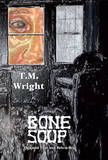 Cemetery Dance / Fall 2009
Cemetery Dance / Fall 2009
Reviewed by: Blu Gilliand
Bone Soup is subtitled “This and That and Bric-a-Brac,” a perfect description of this eclectic mix of stories, poems and artwork by the multi-talented T.M. Wright. Like any good soup, this collection takes a variety of ingredients and melds them into a rich, satisfying dish with a taste all its own.
Because I don’t read a wide range of poetry and am far from a connoisseur of art, I will leave the examination of those portions of Bone Soup to those with more educated, discerning tastes. However, I can appreciate a good short story, and while Wright’s material rarely strays into familiar territory, none of the pieces presented here are any less effective for it.
Wright dwells in all kinds of genres with these stories – romance, mystery, redemption, even time travel – but does so with tales that are not the usual plot-driven excursions from Point A to Point B; rather, these are focused examinations of singular, defining moments, decisions and events in the characters’ lives. Reading these stories is akin to being a T.M. Wright character – you find yourself thrust into unsettling situations, confused as to how you got there and slowly realizing that, as bad as things are, they are apt to get even worse.
The centerpiece of this collection is the novel Cold House, a work that exemplifies Wright’s unique style by employing a constantly shifting timeline and point-of-view. In the hands of a lesser talent, these choices would be off-putting and gimmicky; in Wright’s hands, they are integral in pulling readers deeper into the story.
The nightmares in Bone Soup are refreshingly removed from the world of faceless killers with bloody knives, the kinds of fears that we easily laugh off in the sunshine. These are the deeper, more primal fears of loneliness, of failure, of the inability to escape the mistakes and misdeeds of the past. It’s a true talent that can confront you with these fears in such a way that, disturbing as they may be, you can’t help but turn the page and ask for more.
Purchase link for T.M Wright’s Bone Soup coming soon.
Last Days / Brian Evenson
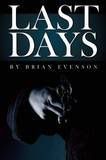 Underland Press / February 2009
Underland Press / February 2009
Reviewed by: Blu Gilliand
Last Days begins with a mysterious phone call. Two voices, one with a pronounced lisp, demanding that a police detective named Kline give them the details of his recent, brutal encounter with a man dubbed “The Gentleman with the Cleaver.” They want to know if he flinched when his hand was cut off. They want to know why he used a hotplate to cauterize the wound before taking off after the “Gentleman.”
From there, the book gets weird.
You have to give big, big kudos to an author that can write about a cult whose doctrine calls for multiple amputations as a sign of a follower’s faith, and can actually infuse the idea with enough pragmatism to have it make a twisted kind of sense. And then he can throw in another cult whose beliefs are more restrained but no less insane, yet its followers remain believable and even sympathetic.
Brian Evenson is one of those authors. And while I’d never read any of his work before, Last Days has made a believer out of me.
Last Days is the first printed shot out of the gate for Underland Press, the publisher best known (until now) for hosting choose-your-own-adventure-style novels by Kealan Patrick Burke and Jemiah Jefferson on its website. With Evenson’s book, Underland has shown that its eye for talent is a strong one.
Evenson may not be a household name, but he’s got eight books and an O. Henry Award under his belt. With Last Days he proves the pedigree is no joke. The story rips along at a blistering pace, dropping the reader headfirst into a dizzying, noir-ish tale of murder, secrets, double-crosses, and the paralyzing power of faith. He regularly turns phrases that make you want to stop and savor them, but the tale refuses to let you linger; you simply must turn the next page and see what’s going to happen next.
Last Days was originally published in 1993 as a novella titled The Brotherhood of Mutilation. That the story has been expanded from its original length, yet still feels as lean and mean as a good short story, is a high compliment to the writer’s skill. Don’t let unfamiliarity with the publisher or the author stop you from giving this one a shot; Last Days is poised to put both Underland Press and Brian Evenson firmly on the map.
Purchase Last Days by Brian Evenson.
Jake’s Wake / John Skipp and Cody Goodfellow
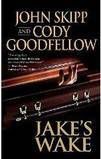 Leisure Books / January 2009
Leisure Books / January 2009
Reviewed by: Joan Turner
John Skipp made his indelible mark upon the horror genre in the 1980s by co-authoring six books with Craig Specter credited with helping invent the Splatterpunk movement. A screenwriter, film director, and musician, to the delight of horror fans everywhere, Skipp burst upon the horror scene anew in the fall of 2007 with his novel The Long Last Call, proving he had lost none of his shock power during his ten-year hiatus. Now, teamed with relative newcomer Cody Goodfellow, author of the Lovecraftian tales Radiant Dawn and Ravenous Dusk, they serve up a buffet of brutal terror in their new Leisure novel, Jake’s Wake.
Jake Connaway began his career as a small time rock star, but discovered two important truths early on: one, the power of his own charisma, and, two, you can get away with (almost) anything if you do it in Jesus’ name.
Trading his guitar for a Bible, he set out to play the televangelist scheme for all it was worth, and soon contributions rolled in and his flock, including the long line of women he used for his own pleasure, grew accordingly.
When Jake meets his end at the hands of a jealous boyfriend, followers and critics alike believe his ministry over, but when he rises from the dead and disappears from the Alta Vista funeral home following a murderous rampage, those closest to him find his true work has only begun.
Jake, believing he has fulfilled his own prophesy of Christian resurrection, unleashes a night of apocalyptic terror that changes the world we know forever. Suspense mounts to an almost unbearable level as readers follow the trail of blood-soaked pages.
John Skipp and Cody Goodfellow breathe new life into the well-worn theme of the corrupt small-town evangelist people love to hate, adding depths and dimensions of horror better read than described. But far from being simply another mindless, gore-filled fun romp, Jake’s Wake offers lessons to be learned – primarily that monsters are made, not born, and beware intrusting anyone with all your heart and soul.
The film adaptation of Jake’s Wake is currently in production under Skipp’s direction, with his previous novel Long Last Call to follow. The godfather of splatterpunk is back with a vengeance!
If you love hardcore horror, don’t miss Jake’s Wake. It’s one of the best yet to come out of the genre, a genuine tour de force of terror.
Purchase Jake’s Wake by John Skipp and Cody Goodfellow.




